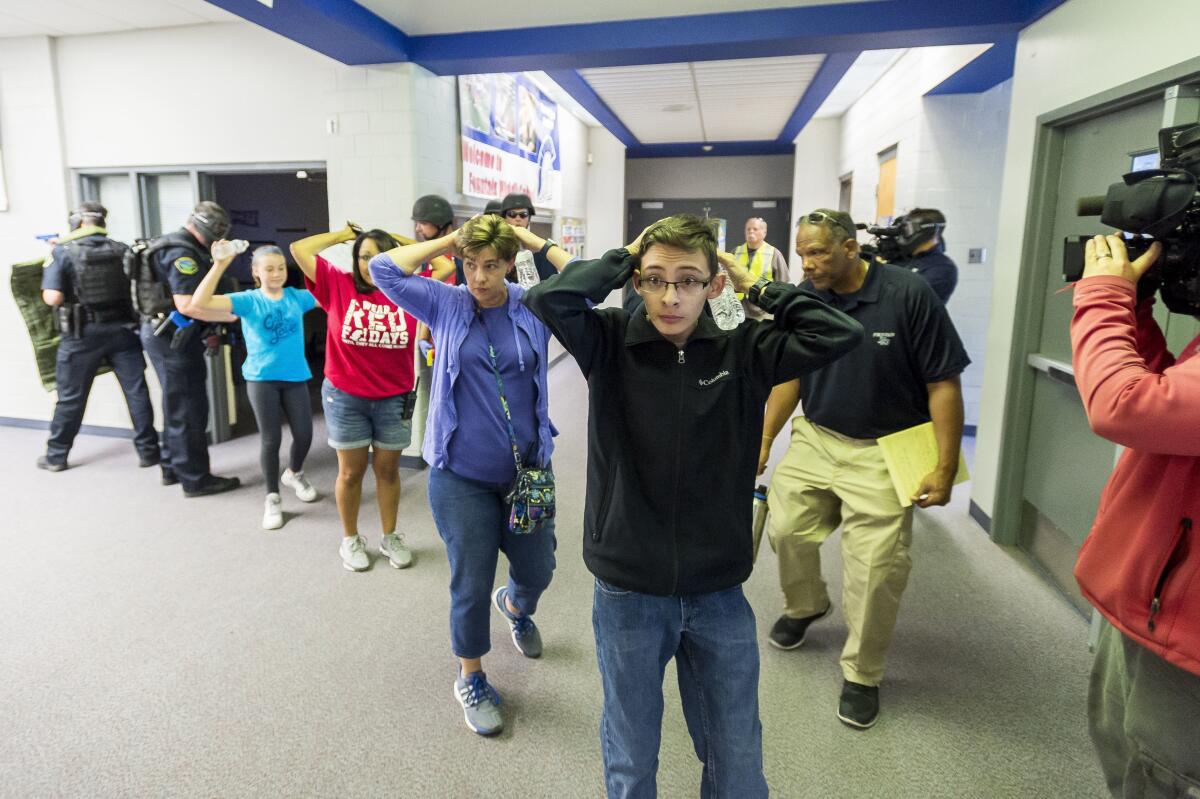Do active-shooter drills in schools hurt students more than they help?

- Share via
In 2015-16, more than three-fourths of the public schools around the country conducted drills to teach students how to react to a shooter on campus, according to the National Center for Education Statistics. In the four years since then, many additional horrifying shootings — especially the killing of 17 people at Marjory Stoneman Douglas High School in Parkland, Fla., in 2018 — have created an even-more-robust business in active-shooter drills at workplaces and schools.
But now, the two major national teachers unions as well as the pro-gun-control group Everytown for Gun Safety are calling on schools to reconsider these drills, saying students are being traumatized by them ahd there’s no evidence they save lives.
Ending all the drills would be going a bit far. Preparation for emergencies — even unlikely ones — isn’t a bad thing; in general, we as a society do too little of it. (Everyone with a comprehensive earthquake pack at home, in a safe and accessible spot, please raise your hand.)
And while it’s true that there’s little conclusive evidence that the drills would make a difference in an actual shooting incident, there’s also little evidence that they wouldn’t make a difference. Luckily for us all, their effectiveness hasn’t been tested in a major way.
At this point, though, the drills seem to do more to make parents and the public feel reassured than to save lives. For all the terrifying recent incidents, students are still extremely safe on campus, far less likely to be killed there than in a car accident or, in many neighborhoods, walking to and from school.
In 2019, eight people were killed in U.S. school shootings, according to Education Week’s school-shooting tracker. In just the past several months, more than 70 children in the country have died of the flu — and yet only about half of Americans get flu shots. More than 10 children die each week in car accidents.
Then there are the drills themselves. They range from activities such as gently instructing students while they remain seated to having them run around barricading doors. In some cases, schools have panicked students by not announcing that the drill was, in fact, a drill. In some cases, people “playing” the attacker in a drill have worn masks to make the scenario more realistic. Schools have used fake blood and fired blanks from guns. Things have gotten so out of hand that teachers in Indiana complained in March 2019 that they had been shot with pellet guns during an active-shooter drill, raising welts and in some cases causing bleeding. This is insanity.
There is abundant anecdotal evidence that the heavy focus on these drills in recent years has rattled students and made them feel less safe at school, not more.
As Melissa Reeves, a professor at Winthrop University and former president of the National Assn. of School Psychologists, put it to National Public Radio, when schools practice fire drills, they don’t light fires in the hallways.
What’s most important is that schools focus on security measures that are safe and effective — and that testing be done to make sure they really are. Remember the popular D.A.R.E. anti-drug program during the 1980s and ‘90s that, after the expenditure of many millions of dollars over many years, proved to be ineffective and even counterproductive?
Funding for school security is limited and should be spent in ways that provide the most protection for the dollar. A November 2019 study by the U.S. Secret Service noted that there are many signs before a shooting that a student might be at risk of attacking others at school. The report suggested that the primary focus of schools should be better counseling, major attention to a school’s social environment — shooters generally had been ostracized or bullied — and strong coordination between teachers and counselors.
The Los Angeles Unified School District has approached safety drills in a far saner manner, taking things slowly and deliberately. It does not hold active-shooter drills at this point while it looks into what programs might be best for its students. District safety officials said they are not planning active drills where students run around panicked, barricading doors. Their focus would be more on safety lessons without the high drama, in all kinds of potentially dangerous situations, including but not limited to shootings, helping students stay aware of where they are and what exits or hiding spaces are available.
Schools throughout the nation should be similarly thoughtful. Learning to be prepared in an uncertain world can be traumatizing — people who were students in the 1960s probably still remember the useless ducking under their desks in the event of a nuclear bomb — or it can be empowering. Schools shouldn’t over-emphasize remote and unlikely dangers, but that doesn’t mean students can’t benefit from basic safety lessons. Without the masked attackers or pellet guns, please.
More to Read
A cure for the common opinion
Get thought-provoking perspectives with our weekly newsletter.
You may occasionally receive promotional content from the Los Angeles Times.









